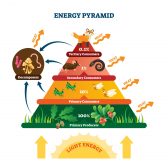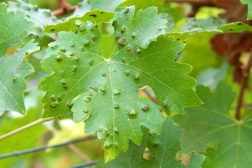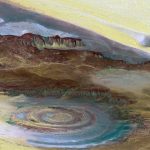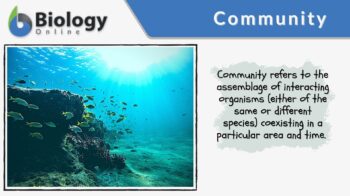
Community
n., plural: communities
[kɔˈmjuːnɪti]
Definition: the assemblage of interacting organisms
Table of Contents
Community, in biology, refers to the assemblage of interacting organisms (either of the same or different species) coexisting in a particular area and time. Because of their interactions, members of a community tend to affect each other’s abundance, distribution, adaptation, and existence. Two of its major properties are community structure and community function.
Community structure pertains to biotic composition whereas community function is associated with energy flow, resilience, and resistance of the community. Apart from these properties, communities share common characteristics.
These are species diversity, species interactions, spatial structure, periodicity, ecotone-edge effect, and ecological successions. A community may range in size from a very small assemblage as in a pond or a tree to huge regional or global biotic associations as in a biome.
Community Definition

The term community has long been associated with a group of humans that may or may not inhabit the same location. A community, in this sense, would be one wherein members share common interests, language, tradition, manners, law, or culture, regardless of the members’ locations. At present, a contemporary community, for instance, is one that is built upon healthier, eco-friendly, and holistic design with the intent to live harmoniously with nature and other life forms.
(Read: Community Planning Factsheet – Building Biology Institute)
In biology, a community is a group of interacting organisms that may be of the same species or not as long as they share a common habitat. They interact with one another through symbiotic relations, e.g. mutualism, parasitism, commensalism, or competition. Similarly, in ecology, a community is defined as the association of a group (or groups) of species that co-inhabit a geographical area over a particular time. To be precise, an ecological community refers to the assemblage of living organisms having symbiotic relationships among themselves, and thus functioning, at least to some degree, as an ecological unit.
Etymology: The term community comes from the Latin “communicate”, nominative communitas, meaning “society” or “fellowship”. In ecology, a community is also called biocenosis. The term coined in 1877 by Karl Möbius, a German zoologist and ecologist. Synonyms: biocenosis or biocoenosis.
Community vs. Ecosystem
Ecological community and ecosystem are different but related concepts. While a community pertains to the group of species interacting and living together in a particular habitat an ecosystem is a broader concept. An ecosystem is comprised of not only living things but also of the physical environment that altogether functions as a unit.
An ecosystem would, therefore, include both the biotic and the abiotic factors that are linked to one another, especially for energy and biogeochemical cycling. It should be noted, however, that an ecological community may omit the abiotic factors in its definition but these factors would have an effect on its structure, pattern, abundance, and stability.
All things considered, an ecosystem would, therefore, be comprised of several communities in a particular environment. For a more detailed comparison between community and ecosystem, see the table below.
Table 1: Difference Between Community and Ecosystem | |
|---|---|
| Community | Ecosystem |
| Comprised of living things (biotic factors) interacting and living together in a habitat | Comprised of biotic factors (living things) and abiotic factors (non-living things) in a particular environment |
| Basic biotic components are producers (e.g. plants), consumers (e.g. animals), and decomposers (e.g. bacteria) | Basic biotic components are producers, consumers, and decomposers whereas abiotic components are climatic factors (e.g. sunlight, humidity, temperature, atmosphere, etc.), edaphic factors (soil type, the geology of the land, etc.), and social factors (e.g. land use, water resources, etc.) |
Community examples:
| Ecosystem examples:
|
Data summarized by Maria Victoria Gonzaga for Biology Online
Properties of Community
Recognizing a biological community can quite be a confounding task as assemblages of organisms could sometimes overlap with one another. Nevertheless, they have distinctive properties, i.e. community structure and community function.
- Community structure pertains to the biotic composition of the community. It entails species abundance and diversity as well as the trophic relationships that the members of a community establish.
- Community function, in turn, includes energy flow, resilience, and resistance. The energy flow in a community entails the course of energy, for instance, as it flows through the various trophic levels in a food chain. Resilience and resistance are two important attributes. Since assemblages of organisms can be influenced by biotic and abiotic changes, they must be able to resist changes in order to achieve stability. A stable community is one that can resist, or at least rebound from these changes. The rebounding from a perturbation or disturbance is referred to as resilience whereas the defying of the effects of the perturbation or disturbance is known as resistance.1 Measuring or identifying the equilibrium state can be difficult though. Sometimes, it could take several years of observation to determine the point of stability.
Characteristics of Community
Apart from the distinctive properties, communities share common features that can be useful for their identification. Some of the major characteristics of a community are as follows:
- Species diversity
- Species interactions
- Spatial structure
- Periodicity
- Ecotone and the edge effect
- Ecological successions.
Species diversity
Diversity pertains to the complexity of species in a community. It can be determined by species richness and by species evenness (i.e. the relative abundance of species). Species richness refers to the number of different species co-inhabiting a particular area. For instance, areas near the equator tend to have the greatest species richness since the environmental conditions (e.g. low seasonality and high rainfall) are more conducive to a wider range of species as opposed to areas near the poles.
Another important measure is the relative species abundance. It refers to the number of individuals in a species with respect to the number of individuals in all species in a given habitat. Foundation species often have the highest relative species abundance. Foundation species in a community are often represented by the primary producers. They bring into the community most of the energy as they are able to convert light energy into chemical energy. They are able to store energy in biomolecules such as carbohydrates. Because of this ability, they may serve as a food source for other organisms, such as consumers. Consumers (producers as well) serve as a source of nutrients for decomposers as the latter decomposes dead or decaying organic matter.
In a community, there is often a dominant population that influences more than the others. This dominant species is referred to as ecological dominants. Plants in a community are often the ecological dominants. Thus, they are also used as the basis for naming a community, e.g. oak forest community, grass community, etc. Another special type of species is the keystone species. This species is regarded as a key because their removal could lead to the collapse of the community. Keystone species are essential in maintaining biodiversity and upholding the structure of the community. An example of a keystone species is the banded tetra fish that in nature provides much of the phosphorus to the community. Thus, removing this fish species could lead to the destruction of its community.
Species interactions
Species interactions in a community may be direct or indirect. Direct interaction is one in which there is direct physical contact between interacting species. An indirect interaction is a form of species interaction wherein an intermediary species mediates the interaction between the two species. The interaction may also be linear or circular. A linear interaction is exemplified by a competitive hierarchy whereas a circular interaction is by a competitive network.
Spatial structure
The structure of a community may be represented through zonation or through stratification. In zonation, a lake community, for instance, can be divided into zones: littoral zone, limnetic zone, and profundal zone. Each zone contains different types of organisms.
A typical structure of a lake ecosystem. Source: Maria Victoria Gonzaga of Biology Online.
The more common structure is stratification. The development of different species could result in the formation of different strata. For example, the sea may be divided into upper and lower strata. The upper stratum is often inhabited chiefly by the autotrophs whereas the lower stratum is inhabited mainly by the heterotrophs.
Periodicity
The biological activities in a community are often rhythmic and therefore may be predicted by periodicity. For example, some organisms (diurnal) will be active during the day whereas others at night (nocturnal). Many living organisms in a community are influenced by circadian rhythms.
Ecotone
Adjacent communities may be identified by the presence of an ecotone. An ecotone serves as the boundary between two communities. It is often a transitional state and therefore more likely to be denser and richer than the two nearby communities. Species that are restricted at the ecotone are referred to as edge species. Examples of ecotones are streams running through a meadow and an estuary where the rivers meet the sea.
Community dynamics
A disturbance (e.g. volcanic eruption, fire, earthquake, etc.) could affect communities. A once-stable community, for instance, may fail to bounce back to its equilibrium state after a disturbance. When this happens, the original community could be replaced with a new one. This is called ecological succession.
Ecological succession refers to the directional and progressive change of communities in a given area over time. There are two types of succession: primary and secondary. In primary succession, a community colonizes a newly formed land. In secondary succession, a new community replaces the first one after the disturbance. The pattern often starts at the pioneer species, such as grasses and perennials. After some time, higher forms of plant species (e.g. shrubs and pines) grow. They are referred to as the intermediate species. Finally, more advanced plant species grow (e.g. oak and hickory). When stability is reached (again), the assemblage is referred to as the climax community. Equilibrium is kept until the next disturbance.
Types of Communities
Community size may vary and overlap. In this regard, communities may be typified as major or minor. Major communities span larger geographic areas and apparently independent over neighboring communities. Minor communities are relatively smaller and more or less dependent on adjacent assemblages. Thus, minor communities may make up a larger, major community.
A community may also be classified as either open or closed. An open community is a community wherein the organisms, particularly plants, are distantly placed and therefore new invasion is possible. A closed community is one in which the organisms are closely placed. Thus, it is closed for any organism to further inhabit the area.
Importance
Community is important because it allows species interaction. Species interact within a community for various reasons, and one of them is nutrition. Animals, for instance, are not capable of making their own food and therefore have to rely on plants and other animals for nutrition. Plants, on the contrary, can make theirs through photosynthesis. However, they also depend on animals as one of the major sources of carbon dioxide.
This gas is released as a waste product of metabolism in animals. Plants, in turn, need it as a chemical reactant for photosynthesis. In return, they give off oxygen that the animals breathe in for their metabolic needs. Apart from nutrition, members of the community may also provide a protective shelter. A tree, for instance, can be a habitat for various organisms, such as epiphytes, lichens, insects, and arachnids.
NOTE IT!
Wallace’s Line – Exploring the Biogeographical Factor in Unique Communities
If you look closer at the distribution and biogeography of species in the course of history, you will unveil astounding stories of species adaptation and evolution.
In 1859, British naturalist Alfred Russel Wallace came up with a demarcation line, called Wallace’s Line, that divided the east and the west. This is what this line delineates:
» Creatures in the west looked more like the mainland Asian species
» Creatures in the east looked more like their Australian counterparts
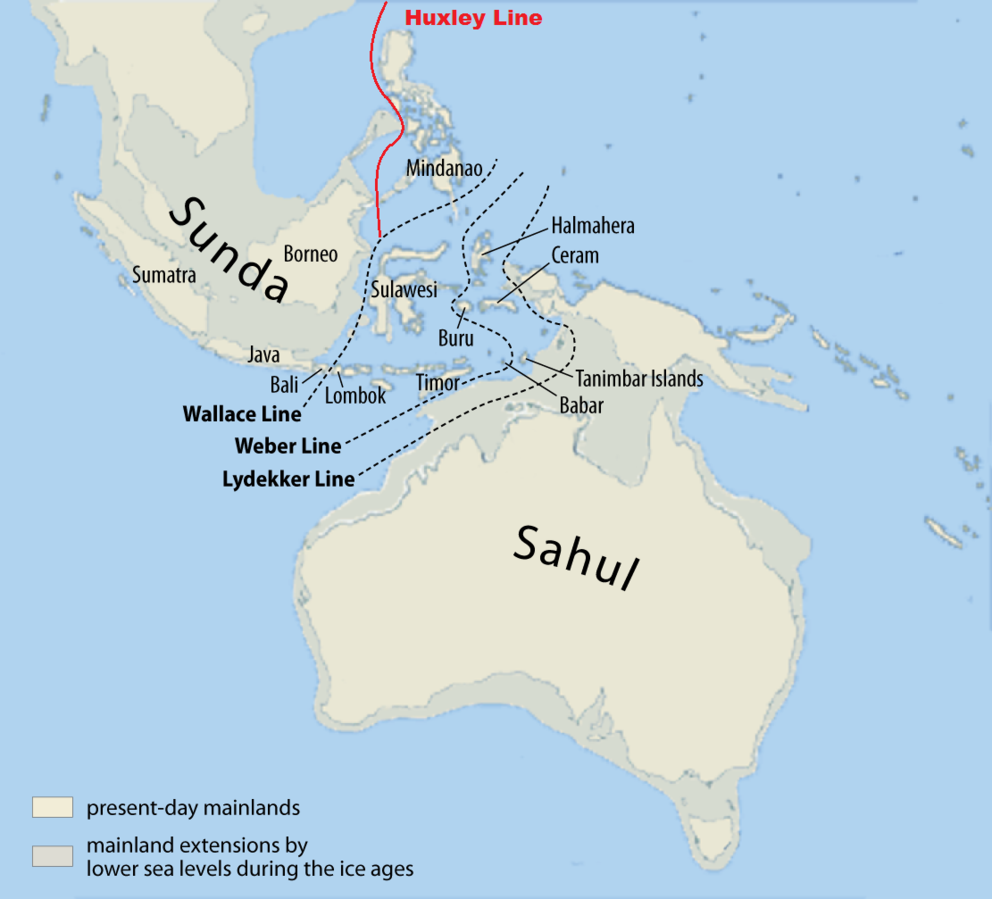
This supports the notion that ancient lands were pregiously connected, allowing extensive species intermixing and community interactions. But over time they were eventually separated, or isolated from the rest.
In the early times, the sea level in such areas was lower than it is today (indicated by the gray color in the map below). Land connections between some islands thus existed and allowed land species to cross or migrate.
Over time, though, there came a point when these species could no longer leave the island mainly because the sea level rose. Species adapted to their own environments. Some of them evolved into new species that are remarkably different from the species on the other side.
This is the same narrative where biogeography and community distribution served as some of the major factors that generated distinct biological communities, such as the unique flora and fauna in New Zealand and the rich biodiversity in Australia.
Take the Community – Biology Quiz!
Further Reading
- Ecology Definition
- Population Definition
- Symbiosis Definition, Types, and Examples
- Ecology & Biodiversity: New Zealand Flora & Fauna > Community Patterns
- Freshwater Ecology > Running Water Freshwater Community Factors
References
- Odum, E. P. (1959). Fundamentals of Ecology, Second edition, Philadelphia and London: W. B. Saunders Co. p.546
- Community and Ecosystem Dynamics. (2019). Retrieved from Estrellamountain.edu website: https://www2.estrellamountain.edu/faculty/farabee/biobk/BioBookcommecosys.html
- Sarkar, S. (2016). Ecology (Stanford Encyclopedia of Philosophy). Retrieved from Stanford.edu website: https://plato.stanford.edu/entries/ecology/
- Why Measure Biodiversity? (2009). Retrieved from Uidaho.edu website: https://www.webpages.uidaho.edu/veg-measure/Modules/Lessons/Module 9(Composition&Diversity)/9-2-Biodiversity.htm
- Ecological Succession. (2009). Retrieved from Psu.edu website: https://www.psu.edu/dept/nkbiology/naturetrail/succession.htm
© Biology Online. Content provided and moderated by Biology Online Editors




